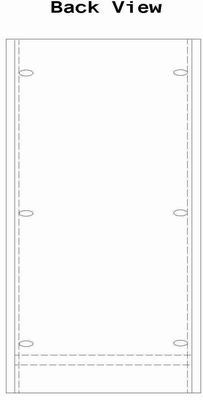Question
I'm trying to make veneered columns for an entertainment center. I've purchased PVC pipe and paper-backed veneer. I did a quick test with contact cement and it doesn't appear to bond to PVC. Does anyone have suggestions?
Forum Responses
PVC pipe can be an excellent substrate, but it must be prepared. The surface has a glaze that must be treated or removed. You can prime it or you can sand it and you can do both. Sanding works well and you won't have to find primer. I think the rougher surface helps the bond also.
Locke Wilde, forum technical advisor
Comment from contributor A:
We used to veneer PVC columns until we installed one in a house that didn't have heat hooked up. The PVC shrunk and made a real mess. We don't recommend doing it anymore.
The veneering method is more production efficient and permanent than all the aforementioned methods due to the adhesive I used - clear PVC cement loaded in my HVLP spray gun. The results were incredible in the flatness - no telegraphing of lumpy contact cement, and clear glue squeeze-out through the pores of the wood took the high-solids topcoats without any discoloration. The key to success is speed in the following:
Make a clamping sleeve out of .010 - .020" decorative, perforated aluminum, the kind used for radiator grills that simulate chair caning. It should wrap around the pipe exactly, and you must attach 3/8" x 3/4" oak strips with a 70° bevel (3/4 face down) to the long edges of this metal sleeve using epoxy for super strong bond into the perfed metal. You will clamp the sleeve around the pipe with three or four wood hand-screw clamps (long edges of jaws), one clamp every foot of length.
Now load the spray gun (large nozzle for thicker paint) with clear PVC cement, thinned a little with solvent cement or MEK, or straight. Do outdoors or in good booth for fume evac, though there will be no suspended overspray. Spray the raw veneer heavily - say 30 mils, place the veneer in the sleeve and immediately lay the pipe into the wet cement and clamp immediately.
Bond time is about four minutes. Remove clamps after seven minutes for a full solvent weld of the veneer to the pipe - totally permanent. I veneered about ten columns an hour, and have done close to sixty columns, 3" and 4" DIA in these three grand mirrors using hand selected, bookmatched (left vertical column mirrored the right column) veneers from fiddleback redwood, pommelle sapele, quilted maple, quartered Avodire, to easy bending fiddleback makoreŽ.
The other adhesive method that was quite revolutionary to me for strong structural bonding of wood to PVC or other solvent-softening plastics is a wet-on-wet adhesive method by bedding plywood coated with PL Premium polyurethane into PVC that was primed with wet PVC cement. The two adhesives bond molecularly, then solvent weld into the plastic. I had to do structural break tests on this type of joint because my mirrors - at over a hundred pounds - were hung on walls where the hanging wire was mounted to 3/4" x 1" x 40" plywood rips that held the weight, and were bonded to the inside radii of the PVC pipe using this method. Tests were done with a variety of serious adhesives on roughed-up PVC, but break tests on the W-O-W method showed primary substrate failure, not glue joint failure - on smooth PVC. I absolutely guarantee that there is no stronger adhesive tactic for wood to plastic due to the incredible adhesion of the polyurethane on the wood, as we all know with PL Premium, coupled with the solvent weld to the PVC.
